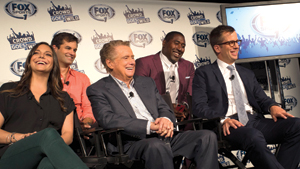Last week, I wrote about problems
Fox is having persuading distributors to carry its fledgling
FS1.
Some have suggested the story — and the fact that Fox is looking to get a license fee that’s three times higher than Speed — is further evidence that sports rights are climbing at an unsustainable rate. Throw in the sports channel carriage fights in Houston, Portland and San Diego, and talk of a sports bubble that’s about to burst becomes inevitable.
That talk is dead wrong, according to a super majority of my best sources. These executives believe the sports media industry is no closer to a bursting bubble than it was in 1993, when talk of a sports rights bubble first emerged. That was when Fox Sports outbid CBS by more than $100 million per year for the rights to the NFL’s NFC package. At the time, industry insiders thought the price was so outlandish that there was no way Fox would make money off that deal. Of course, the deal worked for Fox, and rights fees have risen ever since.
For as long as I’ve covered the media business, people have been sounding an alarm about a sports rights bubble. Every five years or so, it gets louder. I don’t get the sense that there’s any more validity to it today than there was 20 years ago.
 |
Fox Sports 1, which rolled out its “Crowd Goes Wild” personalities last week, is having tough talks but not tough times.
Photo by: TOMMY GILLIGAN
|
It was loud in 1998, when distributors signed contracts that allowed
ESPN to increase its affiliate fee by 20 percent a year. Such increases would surely price cable and satellite services too high for consumers.
They didn’t.
There was outcry around 2002, when the New York Yankees launched YES Network. Distributors would be priced out of the market if every team decided to launch its own network.
That didn’t happen, either.
The bubble talk got louder again around 2007, when the Big Ten Network launched. What if every conference — what if every school? — launched its own network? How could distributors afford that?
In ensuing years, distributors figured out ways to post record profits.
Now in 2013, talk of the sports bubble is back in vogue.
With or without a bubble, the sports media industry is certain to see some changes. Sports rights, which have seen huge increases over the past decade, almost certainly will level off. Several of the new sports channels will fail. But that’s more evidence of a vibrant marketplace rather than a bubble bursting. In fact, the networks and leagues have structured deals in such a way that if there is a bubble to burst, it won’t happen for another 10 years, at least.
The most recent media-rights deals run well into the next decade. The NFL signed deals through the 2022 season. MLB’s deals run through 2021. In college, deals run toward the end of the next decade.
The NBA, NASCAR and Big Ten are the next properties to go to market, and you can bet that they will cut deals that run into the next decade, too.
If the sports rights market is a bubble that’s going to burst, it won’t be because of these long-term contracts. It won’t be from the distributor side, either. Distributors need the avid fan bases sports programming provide. Reruns of “The Big Bang Theory” on TBS may bring in more total viewers and more younger viewers than ESPN’s “Sunday Night Baseball,” as it did last week and most other weeks. But ask sponsors where they’d rather advertise. It’s with sports’ more-engaged audience. Ask cable operators what’s more important to them. ESPN is the only place to see “Sunday Night Baseball.” You don’t need cable to watch episodes of “The Big Bang Theory.”
The FS1 negotiations with Time Warner Cable show why it’s hard to believe a sports bubble exists. The deal almost certainly will get done — either in the weeks before or the weeks after launch. But negotiations between these two huge media companies involve much more than sports. FS1 is one asset of many that are involved in these negotiations.
The idea that the value of sports will drop seems naïve. The sharp increases may moderate, but it only takes two companies to make a market. With ESPN, Fox, NBC, CBS, Turner and others vying for live sports rights, the market for sports rights will remain vibrant for a long time.
John Ourand can be reached at jourand@sportsbusinessjournal.com. Follow him on Twitter @Ourand_SBJ.





